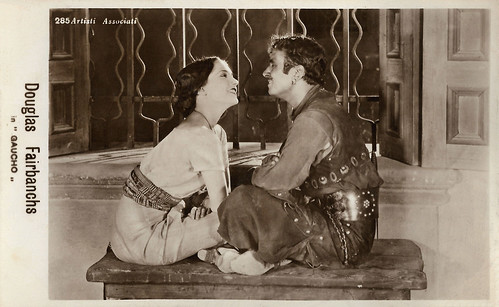
Italian postcard by G.B. Falci Editore, Milano, no. 285. Photo: United Artists. Douglas Fairbanks and Lupe Velez in The Gaucho (F. Richard Jones, 1927).
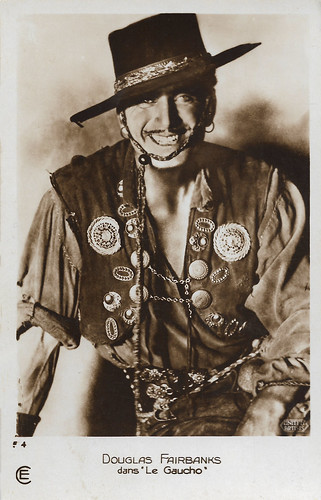
French postcard by Cinémagazine-Édition, Paris, no. 54. Photo: United Artists. Douglas Fairbanks in The Gaucho (F. Richard Jones, 1927).

French postcard by Cinémagazine-Edition, Paris, no. 479. Photo: Lynch. Douglas Fairbanks in The Gaucho (F. Richard Jones, 1927).
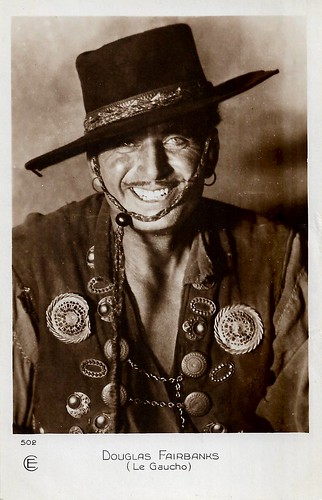
French postcard by Cinémagazine-Edition, Paris, no. 502. Douglas Fairbanks in The Gaucho (F. Richard Jones, 1927).
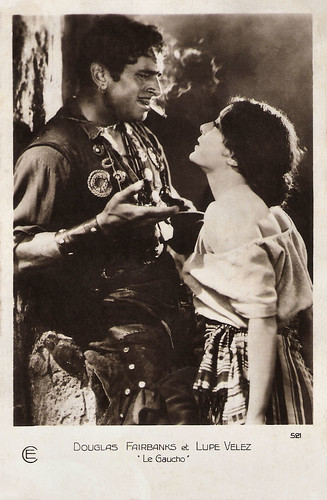
French postcard by Cinémagazine-Edition, Paris, no. 521. Douglas Fairbanks and Lupe Velez in The Gaucho (F. Richard Jones, 1927). Sent by mail in 1930.
A lavish adventure extravaganza
The official full title of The Gaucho (F. Richard Jones, 1927) is Douglas Fairbanks as The Gaucho. The lavish adventure extravaganza was filmed at the height of Fairbanks' box office clout. Reportedly, Fairbanks had the idea for this film, for which he provided a draft as a script under the pseudonym Elton Thomas, during a pilgrimage to Lourdes.
The film is set somewhere in the Argentine Andes (but was shot at Iverson Ranch in Chatsworth near Los Angeles). In a small mountain town, there is a brutal usurper (Gustav von Seyffertitz) who harassed and plundered the residents. A gaucho (Douglas Fairbanks), who with his men want to free the place from the villains, is infected on purpose by a vengeful leper (Albert MacQuarrie) suffering from "black damnation" (the plague) when the leper touches his hand on the spot where the gaucho has a cut. Only by visiting a pilgrimage church, where he meets the guardian of the holy shrine (Nigel De Brulier), who teaches him to pray, can he be cured of his illness through a miracle of faith.
Led by her to the right faith, the Virgin Mary (Mary Pickford!) appears to the gaucho for a few seconds in these moments of greatest piety. One learns that a miracle is said to have happened here once: a girl was saved from falling a steep wall into the depths through the apparition of the Holy Virgin. Thereupon the believers built the pilgrimage church on this spot, around which the town developed in the following period. This “city of miracles”, as it has been called since then, flourished and prospered and became wealthy, which, as expected, also attracted dark rabble. One day the greedy band of robbers appeared under Ruiz and spread out here.
The gaucho meets a girl from the mountains (Lupe Velez) who falls in love with him. It is a fiery, spirited Señorita who is prone to attacks of jealousy and in one of these moments of excessive passion first becomes a fury and then betrays the gaucho to the troops of the villainous Ruiz. But the Argentine hothead's love for their gaucho is so great that a little later she calls for help to free her lover. In the end, the villains are defeated and driven out, and nothing stands in the way of a future together for the two lovers.
For the then 19-year-old Mexican Lupe Vélez, this film was her breakthrough in Hollywood. New York Times critic Mordaunt Hall wrote after the premiere: "Lupe Velez acts the part of the Mountain Girl, a termagant, quickly fired to anger. Whether she is in rags or laces she gives blow for blow to the men who get in her way or incur her anger. She, too, springs on horseback, never heeding for an instant that she is arrayed in silks and laces. She flies at the Gaucho because of his jests, and you perceive a slapping and biting scene, which suddenly ends in the Mountain Girl and the Gaucho sharing an apple. Miss Velex really gives a capital characterization as the Mountain Girl, but it does seem strange that she is so suddenly tamed at the end when she becomes the bride of the Gaucho."
Ron Oliver at IMDb is as enthousiastic about Fairbanks's performance: "Douglas Fairbanks was at the pinnacle of his fame when he made this wonderful adventure film. His buoyant on-screen charm is matched only by his superb & graceful athleticism. He is secure in his position as one of the very greatest of cinema legends."
Fairbanks biographer Jeffrey Vance considers the film "a near masterwork" and "an anomaly among his [Fairbanks’] works." Vance also considers it a "daring departure, the film is an effort of unanticipated darkness in tone, setting, and character. The spirit of adolescent boyish adventure, the omnipresent characteristic of his prior films, is noticeably absent. It has been replaced by a spiritual fervor and an element of seething sexuality the likes of which has never been seen before in one of his productions."
A new preservation print of The Gaucho, created by the Museum of Modern Art, was first shown at the Academy of Motion Picture Arts and Sciences in 2008. It has subsequently been screened at MoMA (2008), and the San Francisco Silent Film Festival (2009) to promote the new book 'Douglas Fairbanks' with author Jeffrey Vance introducing the screenings.
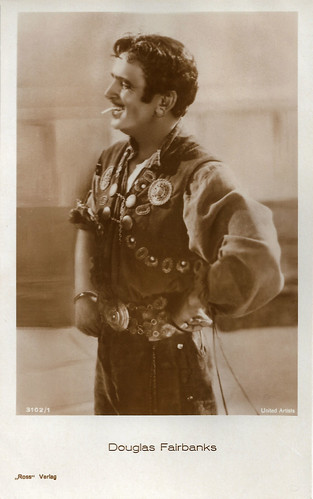
German postcard by Ross Verlag, no. 3102/1, 1928-1929. Photo: United Artists. Douglas Fairbanks in The Gaucho (F. Richard Jones, 1927).

German postcard by Ross Verlag, no. 3102/2, 1928-1929. Photo: United Artists. Douglas Fairbanks in The Gaucho (F. Richard Jones, 1927).
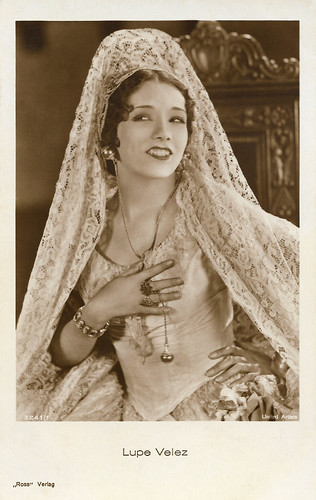
German postcard by Ross Verlag, no. 3241/1, 1928-1929. Photo: United Artists. Lupe Velez in The Gaucho (F. Richard Jones, 1929).

German postcard by Ross Verlag, no. 3243/1, 1928-1929. Photo: United Artists. Douglas Fairbanks in The Gaucho (F. Richard Jones, 1927).
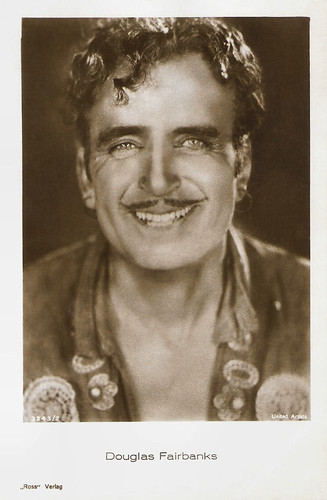
German postcard by Ross Verlag, no. 3243/2, 1928-1929. Photo: United Artists. Douglas Fairbanks in The Gaucho (F. Richard Jones, 1927).
Sources: Mordaunt Hall (The New York Times), Wikipedia (English and German), and IMDb.
No comments:
Post a Comment